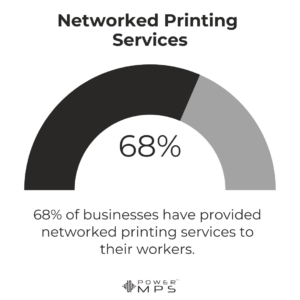3 Ways Office Printing Will Continue to Evolve With Hybrid Work
Covid-19 brought a massive shift in how individuals work, and businesses run. To survive, companies had to find ways to make a way for employees to work outside the office. But the employee experience and business investments are making a return to pre-COVID offices a much more difficult prospect. The result is an environment in which remote work, whether part- or full-time, has become a common practice for many professionals.
The move to remote work spawned numerous noticeable changes in workplace printing – none of them the much-anticipated death of office print. Rather than turning completely digital, employees notoriously boosted sales of home printers to handle documents for their new home office. Today, well over half (66%) of CEOs are already or have plans to reconfigure their office spaces to support long-term hybrid work. Another 63% of rapidly growing companies already employ hybrid work structures.
Here are three ways in which remote and hybrid work are changing how offices manage and interact with printing.
How Employees Print at Home is Changing
That early run on home printers at the beginning of COVID? Many of those remote and hybrid workers are still hooking into those small inkjets to print out their everyday documents. But the slow, clunky home inkjets and laser options are rarely able to fulfill the real needs of long-term hybrid workers.
Permanently hybrid or remote employees are discovering the need to print longer documents such as legal and tabloid sizes. And there is a desire to not only print effectively but efficiently as well. Over a quarter (35%) of hybrid or remote employees would prefer double-sided, or duplex, printing.
In addition, professionals are increasingly embracing coworking spaces to access services they used to rely on in the office. One of the big drivers to coworking, like WeWork and WorkBar is the ability to use larger-format, office-grade printing equipment. But these same hybrid workers would prefer smoother, more secure printer connectivity through their company – something where they don’t have to deal with driver installations or pay additional fees.
But providing the usual large, office-grade printers for remote use isn’t an option. Rather, businesses have to find solutions that will fit smaller spaces without compromising print efficiency.
More Networked Printing

Consumer-grade printers aren’t just slow, they are a potential security risk. The printers designed and sold for home use lack the security software that can lock out bad actors, thus creating a vulnerability in a company network each time an employee links into the printer on their home wi-fi.
To combat this growing issue, IT departments must provide hybrid and remote workers with more secure means of accessing print. Today, over 68% of businesses have provided networked printing services to their workers. In most cases, printing access is some combination of small-format office-grade printers such as A4 machines and remote printing access to the larger on-site printers at their main office.
Small A4 printers can handle the majority of document printing most hybrid and remote workers require, including duplex and larger format sizes – all with the added security features available through office-grade networked systems. But remote printing allows workers to queue documents for printing at the main office on days they are planning or scheduled to be in. This eliminates the risks of damaging documents or transporting sensitive company information to or from remote offices.
Regardless of how employees choose to print, office-grade networked equipment and remote printing are sure to provide safe, quality printing for employees.
Rising Demand for Sustainability and Resources
Employee demand is not the only consideration affecting office print trends. Inflation has hit every aspect of business and printing is no exception. Prices for everything from paper to ink and toner have risen by staggering amounts. And many companies are looking at office print supplies and strategies to see where they can potentially cut costs.
Leveraging the latest in printer technology for the remote and hybrid workforce is one way to help lower overall printing costs. Today’s modern office-grade printers are designed to operate more efficiently and effectively than ever before – limiting toner and ink use, pulling less electricity, and providing ways to limit paper waste such as duplex printing.
Even better, networked printing technology can monitor both on-site and remote printers to help monitor supply levels and printer use. This information can offer businesses the opportunity to make more educated supply purchases and provide opportunities to motivate employees to be more environmentally conscious when it comes to choosing what to print.
MPS Provides Opportunities to Meet These Needs
With the rise in remote and hybrid office work, it is hardly surprising to discover managed print services (MPS) are becoming more in demand. While in-house IT departments have traditionally managed printer security, networking, and services for main office printers, managing a more widespread printer system is a completely different animal.
Beyond leasing or renting equipment, MPS providers are capable of offering a complete print service solution. Their contracts can include security software, monitoring, first-line and second-line maintenance, network setup and management, print optimization, and even regular print reporting. In most cases, the span of services is customized based on the needs of the business. And companies using MPS usually experience significant in pricing, information security, print production, environmental footprint, and agility.
In a remote office setup, MPS offers high-grade small-foot printers without the large capital expense, power usage, and supply headache. And their larger service networks offer printer maintenance, connectivity, and security to workers in multiple locations.
Hybrid and Remote Work are Evolving the Office Print Ecosystem
The changing workspace, despite being largely digital, is still an environment reliant on office printing. But the needs of employees and companies for print are fluctuating to fit new methods of work. Fortunately, managed print service companies are able to offer businesses affordable and flexible ways to meet the needs of their employees and business.


Comments (0)